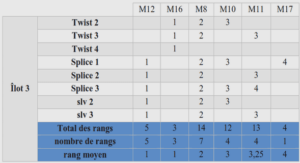Article soumis à IEEE Information Theory
It is now well established that using multiple transmit and receive antennas po- tentially allows to increase the Shannon capacity of digital communications systems. Since the seminal work of Teletar ([1]), the ergodic Shannon capacity of block fa- ding MIMO systems has been studied extensively and important questions related to the design of optimal precoding schemes have been addressed. Considering that the Channel State Information (CSI) is available at receiver side while the transmitter is only aware of its second order statistical properties, many authors have studied the impact of antenna correlation on the capacity of MIMO systems communicating through at fading channel ([32], [33]) and frequency selective channel ([34]). The ergodic Shannon capacity is certainly a valuable gure of merit if the MIMO system under consideration is equipped with a maximum likelihood decoder. As the practical implementation of this decoder requires a high computational cost, it is also useful to study potential performance of MIMO systems equiped with the MMSE receiver. The corresponding (Gaussian) ergodic mutual information (EMI), denoted Immse in the following, is dened as the sum over the transmit antennas of the terms E(log(1+βj)), where βj represents the output MMSE SINR associated to the stream sent by antenna j. The design of precoders maximizing Immse is of course an impor- tant issue because the optimum value of Immse represents the maximum rate that can be transmitted reliably when the MIMO system uses the MMSE receiver. This optimization problem has been extensively studied in the past, mainly if the CSI is available at the both the receiver and the transmitter (see e.g. [8]).
It is however In the present paper, we consider a at fading MIMO channel with separable cor- relation structure (Kronecker model). We assume that the channel matrix is known at the receiver side, but that only its transmit and receive covariance matrices are available at the transmitter side. We address the problem of designing precoders that maximize Immse. The expression of Immse is rather complicated and thus dif- cult to maximize w.r.t. the precoding matrix. In particular, it seems dicult to establish that the left eigenvectors of an optimal precoding matrix coincide with the eigenvectors of the transmit correlation matrix as in the context of the evaluation of the Shannon ergodic capacity (see e.g. ([32]). Therefore, it is necessary to evaluate numerically both the singular values and the singular vectors of optimum precoding matrices, or equivalently to solve a t2 dimensional optimization problem. Steepest descent algorithms require the use intensive Monte Carlo simulation technics in or- der to evaluate the gradient and/or the Hessian of the cost function (see e.g. [35] in the context of the evaluation of the Shannon capacity of correlated Rician channels). Moreover, the convergence of these algorithms is not guaranteed because Immse is in general not concave. As in previous contributions addressing the behaviour of the Shannon capacity of MIMO systems ([10], [11], [12]), we propose to replace the maximization of Immse by the maximization of an approximation obtained in theLarge system approximation of Immse was previously considered in the context of CDMA systems with i.i.d.
spreading codes (see e.g. [36] and the references he- rein), which, in the downlink, are formally equivalent to a subclass of the MIMO systems considered in this paper when the spreading codes are Gaussian. The speci- c case of MIMO systems has also been considered (see e.g. [37], [10]). It was shown that the SINRs (βj)j=1,…,t converge towards deterministic terms depending on the transmit and receive covariance matrices (or their equivalent in the context of down- link CDMA systems). These results provide an obvious large system approximation ˆ ) ([15], [16]). We therefore propose to use an improved large system approximation, deno- ted Immse, rst introduced in [17] in the case of independent identically distributed (i.i.d.) MIMO channels, and then generalized independently in the conference papers [38] and [18]. The derivations of [18] are based on the replica method, a useful and powerfull trick whose mathematical relevance has not yet been established in the present context, and thus dier from the large random matrix approach sketched in [38]. We show that the relative error associated to Immse is a O( 1[39], a paper devoted to the asymptotic study of the SINRs (βj)j=1,…,t. The transmit covariance matrices of the MIMO channels of [39] are diagonal. This assumption simplies the analysis so that the approach of [17], [39] cannot be generalized to the case of general transmit covariance matrices. Next, we address the maximization of Immse w.r.t. the precoding matrix. We establish that the left singular vectors of an optimum precoder are the eigenvectors of the transmit covariance matrix and that its right eigenvectors matrix is equal to It. The evaluation of a precoding matrix thus reduces to the evaluation of its singular values, a t-dimensional optimization problem. In general, the optimum singular values have no closed form expression.



